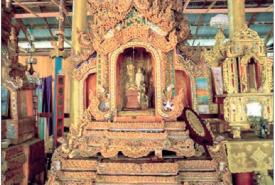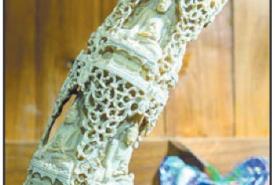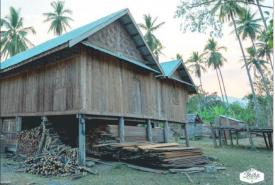16 March
ON my arrival in Bawlakhe of Kayah State, I unexpectedly saw ancient cultural and historical buildings catching attention of travellers. Those wishing to enjoy exploration for new destinations may prefer to pay visits to town and villages in the township rather than the urban area of Bawlakhe. So I would like to share experiences on my visits with other travellers.
What is Bawlakhe?
It is a tranquil town where departmental offices open. Not only Kayah ethnics but also Yin-tale ethnic reside there. I think travellers should wonder around their villages. I seem number of those in Bawlakhe who believe in Buddhism and gods may be larger than those from other towns in Kayah State. The town passed the chieftain eras with evidence of chieftain residential houses but many parts of these houses are in degradation. I had noted down that the region was established by Chieftain Fabant-min (Po Byar). The town was named Tabawtakhe concern-ing Shar Creek and Takheshar Creek, and then it changed to Bawlakhe which means a town of parents in Yintale language.
Climate
I have felt hot in Bawlakhe but cold in Loikaw. I think the town would have many rainfalls in monsoon. As the township is facilitated with earthen roads, travellers need to take care of driving not to catch slip in mon-soon.
Saw La Phaw, the patriotic leader of Kayah State
A story about Bawlakhe is not separable with Saw La Phaw because the sites we visited are related to him. When British co-lonialists occupied Myanmar, Kayah ethnic Chieftain Saw La Phaw joined the anti-colonial-ist struggling. He opened his headquarters in Sawlon. In 1888, Sawlon headquarters was occu-pied by British as the Chieftain could not resist against British troops. The Chieftain who did not wish to live under colonial rule established new Sawlon Vil-lage, east of Sawlon town. Now, the village has been upgraded to Ywathit Town.
Visit to around Bawlakhe
It would be an interesting tour due to beauty of environ-ment and ancient cultural build-ings. Young visitors can enjoy recreation at Yepyar Creek and the waterfall. Photographers will have chance to take photos on lifestyle of rural people and natural scenes.
Sawlon Village
On my trip, I firstly paid a visit to Sawlon Village. It was established in early 1246 My-anmar era. Travellers can go to Sawlon Village through a junc-tion of roads to Ywathit and Saw-lon from Bawlakhe. The road to Sawlon Village is a one-way earthen route. Along the route, travellers can enjoy scenic beau-ties on both sides with mountain ranges and creeks. It is about a 30 minutes drive way from Bawlakhe to Sawlon Village. On arrival at the entrance to the vil-lage, travellers can see a school and a monastery. Moreover, they can see a map of village hung at a tree. However, the abbot of the monastery and some villagers cannot tell Myanmar language fluently. Currently, the village is formed with about 20 houses. I have heard some houses were destroyed. In the past, the res-idences of the chieftains were set on fire. Sawlon Village was dubbed as Bagan of Kayah State.
Old military camp near Saw-lon Village
Travellers can pay visit to an old military camp from the village. The map of the village shows the site with a star which means the mine explosion leav-ing machines damaged and res-idents injured.
Spring in Sawlon Village
Travellers can arrive at a spring of a creek, east to the village, which flows into a large creek we saw along the route to Sawlon Village.
Memorial to families of Chieftain Saw La Phaw from Sawlon Village
The tomb pagodas which are memorial to families of Chieftain Saw La Phaw are in teresting destinations for travel-lers. Unexpectedly, buildings at the memorial look like ancient pagodas but genuine tombs. Travellers need to go there along the pavement from the entrance to the village. Most of the local residents cannot know such a memorial. The map shows it as Mote. If travellers ask them about Moke, they can explain facts about it. Almost all the tombs were destroyed due to lack of maintenance because burglars might think something special could be stored in the tombs. Actually, these damaged parts of tombs can bring sadness to the visitors.
Let’s enjoy recreation in Ye-pyar Creek
When I paid visit to Yepyar Creek in February, the water was clean and blue. I think such a creek might be Nampun Creek. Some parts of the creek shape small waterfalls and some has steady flows. As some parts of the creek are deep, visitors should not take careless moves in the creek. In fact, the places where local residents take a bath and wash clothes are safe for swimming.
Ywathit Town
I paid a visit to Ywathit from Bawlakhe again. I noted Ywathit Village was upgraded to sub-township and then Ywathit Town in 2014. Environs of the town are plentiful of teak and hardwood plants. Significantly, coconut palm plants are thriving in the village. Too many coconut palm plants create the town as a sea beach town. On my way to Ywathit, I passed rough hilly roads while enjoying both hilly and valley climatic conditions as well as scene of orange planta-tions. As there is a checkpoint, travellers need not to be late on tour of the village. If possible, travellers should contact local drivers and tour agencies. They must pass three checkpoints of the Tatmadaw and other organ-izations. If officials ask them, they must respectfully give replies. Their return should not be dark.
Ywathit waterfall
The waterfall cannot catch attention of larger number of travellers. They need to take motorboat in Thanlwin River to the waterfall in a drive of about half an hour. The motor road does not reach the waterfall.
Thiri Mingala Golden Mon-astery in Ywathit
More than 150 years old Thiri Mingala Golden Monastery is located in Ywathit Town. A monk said the monastery was built in 1230 ME. There remains one of five monasteries. I saw gilt posts and ancient thrones in the monastery as well as Bud-dha images. Sculpturing works curved on the posts are ancient works. Some ancient teak box-es and utensils were found in the monastery. While visiting the monastery, some foreigner travellers committed stealing cases. Some ceremonies take place on the plot in front of the monastery. Despite no influent spoken skill, the abbots of the monastery give clarification as much as they can.
Hsinswe Monastery(Nyaungkham Monastery) in Ywathit
Hsinswe Monastery, an-other one, was seen other side of the town. On the day when I paid visit to Ywathit, a ceremo-ny to honour a Buddhist monk from the monastery who was one of three monks in winning the title in the entire nation took place there. The monastery was made of wood on a grand scale. The about 150 years old prayer hall of the monastery is under maintenance. Two ancient tusks are the most significant. Buddha images were wonderfully curved on the tusks. The works were created in 1250 ME. A script was mentioned on the tusks as works of Ko Shwe Thaing. I saw ancient clock towers and other utensils at the monastery.
Ancient pagoda and buildings
Before arriving at Ywathit Town, I paid homage to an ancient pagoda on a mound. Despite thinking that Ywathit might be a large village, I saw some development undertak-ings in the town. I saw some brick buildings, shops, depart-mental offices and hospital. The ancient pagoda and monasteries are located at the outskirts of the town. Preparations are be-ing made to construct a gravel road to Mwedaw Pagoda, before arriving at Hsinswe Monastery. Beyond the pagoda, I saw some unidentified, damaged buildings whether these might be ancient pagodas or tombs. The victory land of King Alaungmintayar U Aung Zeya is located over there. After arranging the land of victo-ry, U Aung Zeya conquered his enemies. Travellers may visit the chamber of Saw La Phaw on the way to Hsinswe Monastery.
Coconut oil of Ywathit
Most of travellers buy coco-nut oil as gifts from Ywathit to their homes. The whole town is significantly teemed with coco-nut palm plants.
How to go there
Actually, it is slightly diffi-cult to go to Ywathit Town on own arrangements. So travel-lers should rely on domestic tour agencies, automobiles and tour guides. If not, they should con-tact 09-970478282 of the Treasure Host on the visits to Kayah State.
In fact, Kayah State pos-sesses the lands of natural beauties which need to be explored in addition to an interesting history. I would like to inform trav-ellers about Bawlakhe region waiting for them with beauties.
Have a safe, secure, healthy and happy trip.
Translated by Than Tun Aung
By Thiha (the Traveller @ Thiha Lulin)







